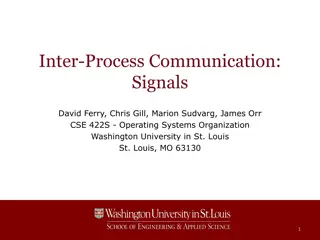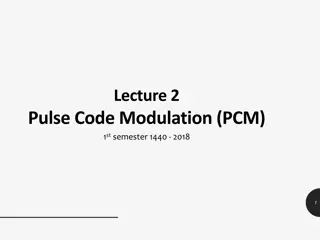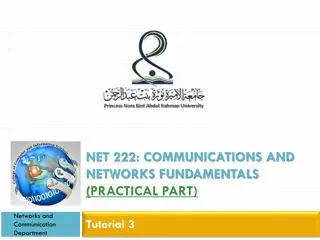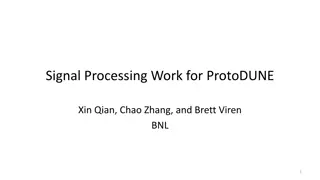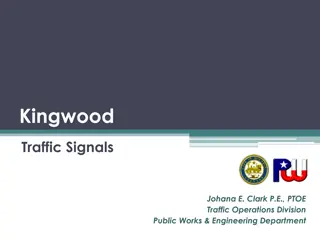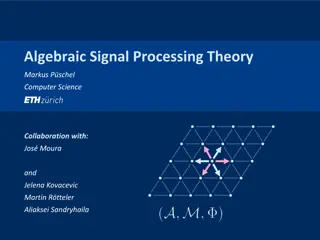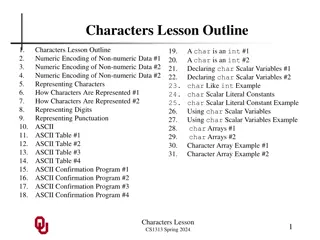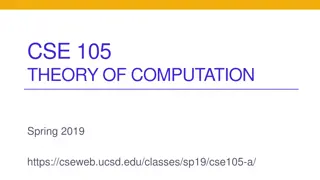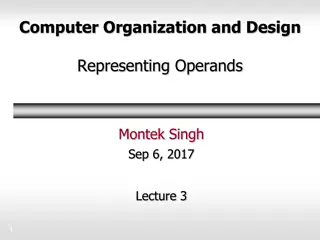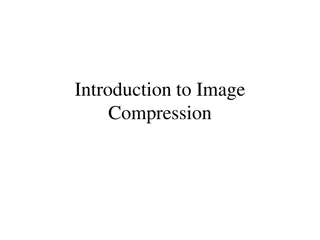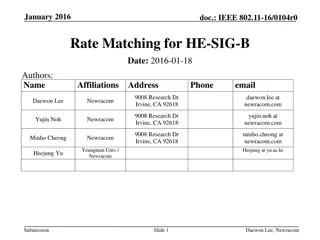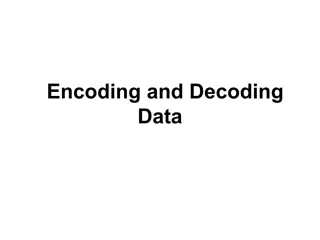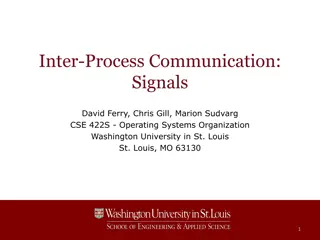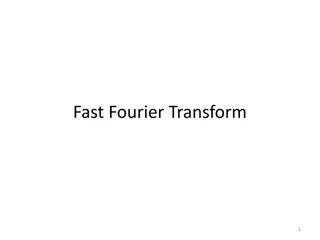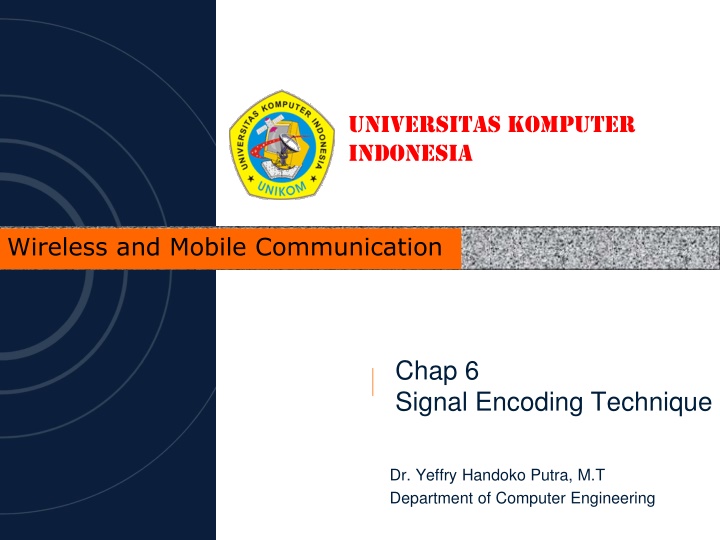
Signal Encoding Techniques for Wireless Communication Systems
Explore the importance of signal encoding techniques in wireless communication systems, including reasons for choosing encoding methods, criteria for successful signal interpretation, and comparison of different encoding schemes. Learn how encoding influences data transmission efficiency and signal quality.
Download Presentation

Please find below an Image/Link to download the presentation.
The content on the website is provided AS IS for your information and personal use only. It may not be sold, licensed, or shared on other websites without obtaining consent from the author. If you encounter any issues during the download, it is possible that the publisher has removed the file from their server.
You are allowed to download the files provided on this website for personal or commercial use, subject to the condition that they are used lawfully. All files are the property of their respective owners.
The content on the website is provided AS IS for your information and personal use only. It may not be sold, licensed, or shared on other websites without obtaining consent from the author.
E N D
Presentation Transcript
UNIVERSITAS KOMPUTER INDONESIA Wireless and Mobile Communication Chap 6 Signal Encoding Technique Dr. Yeffry Handoko Putra, M.T Department of Computer Engineering
Wireless Communication System Channel code word Message Signal Modulated Transmitted Signal Source Encoder Channel Encoder Mod- ulator Source Wireless Channel Source Decoder Channel Decoder Demod- ulator User Received Signal Estimate of Message signal Estimate of channel code word 2 Page 2 leading wireless innovation COMPANY CONFIDENTIAL
Reasons for Choosing Encoding Techniques Digital data, digital signal Equipment less complex and expensive than digital-to-analog modulation equipment Analog data, digital signal Permits use of modern digital transmission and switching equipment Deparment of Computer Engineering Universitas Komputer Indonesia 4
Reasons for Choosing Encoding Techniques Digital data, analog signal Some transmission media will only propagate analog signals E.g., unguided media Analog data, analog signal Analog data in electrical form can be transmitted easily and cheaply Done with voice transmission over voice-grade lines Deparment of Computer Engineering Universitas Komputer Indonesia 5
Signal Encoding Criteria What determines how successful a receiver will be in interpreting an incoming signal? Signal-to-noise ratio Data rate Bandwidth An increase in data rate increases bit error rate An increase in SNR decreases bit error rate An increase in bandwidth allows an increase in data rate Deparment of Computer Engineering Universitas Komputer Indonesia 6
Comparing Encoding Schemes Signal spectrum With lack of high-frequency components, less bandwidth required With no dc component, ac coupling via transformer possible Transfer function of a channel is worse near band edges Clocking Ease of determining beginning and end of each bit position Deparment of Computer Engineering Universitas Komputer Indonesia 7
Comparing Encoding Schemes Signal interference and noise immunity Performance in the presence of noise Cost and complexity The higher the signal rate to achieve a given data rate, the greater the cost Deparment of Computer Engineering Universitas Komputer Indonesia 8
Digital Data to Analog Signals Amplitude-shift keying (ASK) Amplitude difference of carrier frequency Frequency-shift keying (FSK) Frequency difference near carrier frequency Phase-shift keying (PSK) Phase of carrier signal shifted Deparment of Computer Engineering Universitas Komputer Indonesia 9
Amplitude-Shift Keying One binary digit represented by presence of carrier, at constant amplitude Other binary digit represented by absence of carrier ( ) t f c 2 cos A binary binary 1 0 ( ) t = s 0 where the carrier signal is Acos(2 fct) Deparment of Computer Engineering Universitas Komputer Indonesia 11
Amplitude-Shift Keying Susceptible to sudden gain changes Inefficient modulation technique On voice-grade lines, used up to 1200 bps Used to transmit digital data over optical fiber Deparment of Computer Engineering Universitas Komputer Indonesia 12
Binary Frequency-Shift Keying (BFSK) Two binary digits represented by two different frequencies near the carrier frequency ( ( ) t f 1 ) t f 2 cos cos 2 2 binary binary 1 0 A A ( ) t = s where f1 and f2 are offset from carrier frequency fc by equal but opposite amounts Deparment of Computer Engineering Universitas Komputer Indonesia 13
Binary Frequency-Shift Keying (BFSK) Less susceptible to error than ASK On voice-grade lines, used up to 1200bps Used for high-frequency (3 to 30 MHz) radio transmission Can be used at higher frequencies on LANs that use coaxial cable Deparment of Computer Engineering Universitas Komputer Indonesia 14
Multiple Frequency-Shift Keying (MFSK) More than two frequencies are used More bandwidth efficient but more susceptible to error ( ) t = 2 cos s A f t i 1 M i i f i= f c+ (2i 1 M)f d f c= the carrier frequency f d= the difference frequency M = number of different signal elements = 2 L L = number of bits per signal element Deparment of Computer Engineering Universitas Komputer Indonesia 15
Multiple Frequency-Shift Keying (MFSK) To match data rate of input bit stream, each output signal element is held for: Ts=LT seconds where T is the bit period (data rate = 1/T) So, one signal element encodes L bits Deparment of Computer Engineering Universitas Komputer Indonesia 16
Multiple Frequency-Shift Keying (MFSK) Total bandwidth required 2Mfd Minimum frequency separation required 2fd=1/Ts Therefore, modulator requires a bandwidth of Wd=2L/LT=M/Ts Deparment of Computer Engineering Universitas Komputer Indonesia 17
Multiple Frequency-Shift Keying (MFSK) Deparment of Computer Engineering Universitas Komputer Indonesia 18
Phase-Shift Keying (PSK) Two-level PSK (BPSK) Uses two phases to represent binary digits ( ( ) t f c 2 t f 2 binary binary 1 0 cos cos A A ( ) t = s ) + c ) t f c 2 ( 2 cos ( binary binary 1 0 cos A A = ) t f c Deparment of Computer Engineering Universitas Komputer Indonesia 19
Phase-Shift Keying (PSK) Differential PSK (DPSK) Phase shift with reference to previous bit Binary 0 signal burst of same phase as previous signal burst Binary 1 signal burst of opposite phase to previous signal burst Deparment of Computer Engineering Universitas Komputer Indonesia 20
Phase-Shift Keying (PSK) Four-level PSK (QPSK) Each element represents more than one bit A t f +4 cos 2 A 11 c 3 t f + cos 2 01 ( ) t c = 4 s 3 00 t f cos 2 A c 4 10 t f 4 cos 2 A c Deparment of Computer Engineering Universitas Komputer Indonesia 21
Phase-Shift Keying (PSK) Multilevel PSK Using multiple phase angles with each angle having more than one amplitude, multiple signals elements can be achieved R D = R = log L M 2 D = modulation rate, baud R = data rate, bps M = number of different signal elements = 2L L = number of bits per signal element Deparment of Computer Engineering Universitas Komputer Indonesia 22
Performance Bandwidth of modulated signal (BT) ASK, PSK BT=(1+r)R FSK BT=2DF+(1+r)R R = bit rate 0 < r < 1; related to how signal is filtered DF = f2-fc=fc-f1 Deparment of Computer Engineering Universitas Komputer Indonesia 23
Performance Bandwidth of modulated signal (BT) BT + 1 + 1 r r = = ) M R R log L M MPSK 2 ( + 1 r M = BT R log 2 MFSK L = number of bits encoded per signal element M = number of different signal elements Deparment of Computer Engineering Universitas Komputer Indonesia 24
Quadrature Amplitude Modulation QAM is a combination of ASK and PSK Two different signals sent simultaneously on the same carrier frequency ( ) ( ) t f t d t s c 2 cos 1 = ( ) t + t f c 2 sin d 2 Deparment of Computer Engineering Universitas Komputer Indonesia 25
Analog Data to Analog Signal Modulation of digital signals When only analog transmission facilities are available, digital to analog conversion required Modulation of analog signals A higher frequency may be needed for effective transmission Modulation permits frequency division multiplexing Deparment of Computer Engineering Universitas Komputer Indonesia 27
Modulation Techniques Amplitude modulation (AM) Angle modulation Frequency modulation (FM) Phase modulation (PM) Deparment of Computer Engineering Universitas Komputer Indonesia 28
Amplitude Modulation Amplitude Modulation ( ) t s ( ) t = 1+ 2 cos n x f t a c cos2 fct = carrier x(t) = input signal na = modulation index (< 1) Ratio of amplitude of input signal to carrier a.k.a double sideband transmitted carrier (DSBTC) Deparment of Computer Engineering Universitas Komputer Indonesia 29
Amplitude Modulation Transmitted power 2 n = + 1 a P P t c 2 Pt = total transmitted power in s(t) Pc = transmitted power in carrier Deparment of Computer Engineering Universitas Komputer Indonesia 31
Single Sideband (SSB) Variant of AM is single sideband (SSB) Sends only one sideband Eliminates other sideband and carrier Advantages Only half the bandwidth is required Less power is required Disadvantages Suppressed carrier can t be used for synchronization purposes Deparment of Computer Engineering Universitas Komputer Indonesia 32
Angle Modulation Angle modulation ( ) t ( ) t = t f c 2 + cos s A c Phase modulation Phase is proportional to modulating signal ( ) n t = ( ) t m p np = phase modulation index Deparment of Computer Engineering Universitas Komputer Indonesia 33
Angle Modulation Frequency modulation Derivative of the phase is proportional to modulating signal ( ) t ' ( ) t = n m f nf = frequency modulation index Deparment of Computer Engineering Universitas Komputer Indonesia 34
Angle Modulation Compared to AM, FM and PM result in a signal whose bandwidth: is also centered at fc but has a magnitude that is much different Thus, FM and PM require greater bandwidth than AM Deparment of Computer Engineering Universitas Komputer Indonesia 35
Angle Modulation ( )B 1 Carson s rule = + 2 BT n A for PM where p m = n A F f m = for FM 2 B B The formula for FM becomes = + 2 2 BT F B Deparment of Computer Engineering Universitas Komputer Indonesia 36
Analog Data to Digital Signal Digitization: Often analog data are converted to digital form Once analog data have been converted to digital signals, the digital data: can be transmitted using NRZ-L can be encoded as a digital signal using a code other than NRZ-L can be converted to an analog signal, using previously discussed techniques Deparment of Computer Engineering Universitas Komputer Indonesia 37
Analog data to digital signal Pulse code modulation (PCM) Delta modulation (DM) Deparment of Computer Engineering Universitas Komputer Indonesia 38
Pulse Code Modulation Based on the sampling theorem Each analog sample is assigned a binary code Analog samples are referred to as pulse amplitude modulation (PAM) samples The digital signal consists of block of n bits, where each n-bit number is the amplitude of a PCM pulse Deparment of Computer Engineering Universitas Komputer Indonesia 39
Pulse Code Modulation By quantizing the PAM pulse, original signal is only approximated Leads to quantizing noise Signal-to-noise ratio for quantizing noise 76 . 1 2 log 20 SNRdB + = = . 1 + n dB . 6 02 76 dB n Thus, each additional bit increases SNR by 6 dB, or a factor of 4 Deparment of Computer Engineering Universitas Komputer Indonesia 41
Delta Modulation Analog input is approximated by staircase function Moves up or down by one quantization level ( ) at each sampling interval The bit stream approximates derivative of analog signal (rather than amplitude) 1 is generated if function goes up 0 otherwise Deparment of Computer Engineering Universitas Komputer Indonesia 42
Delta Modulation Two important parameters Size of step assigned to each binary digit ( ) Sampling rate Accuracy improved by increasing sampling rate However, this increases the data rate Advantage of DM over PCM is the simplicity of its implementation Deparment of Computer Engineering Universitas Komputer Indonesia 44
1-Mbps Data Rate Deparment of Computer Engineering Universitas Komputer Indonesia
2-Mbps Data Rate Because DQPSK can modulate data bits in pairs, it is able to transmit twice the data rate of DBPSK, or 2 Mbps. Deparment of Computer Engineering Universitas Komputer Indonesia
Example Phase Changes During DBPSK and DQPSK Modulation. Deparment of Computer Engineering Universitas Komputer Indonesia
OFDM Deparment of Computer Engineering Universitas Komputer Indonesia
OFDM Operation with 48 Parallel Subcarriers Deparment of Computer Engineering Universitas Komputer Indonesia
Examples of Phase and Amplitude Changes with 16-QAM. Deparment of Computer Engineering Universitas Komputer Indonesia


